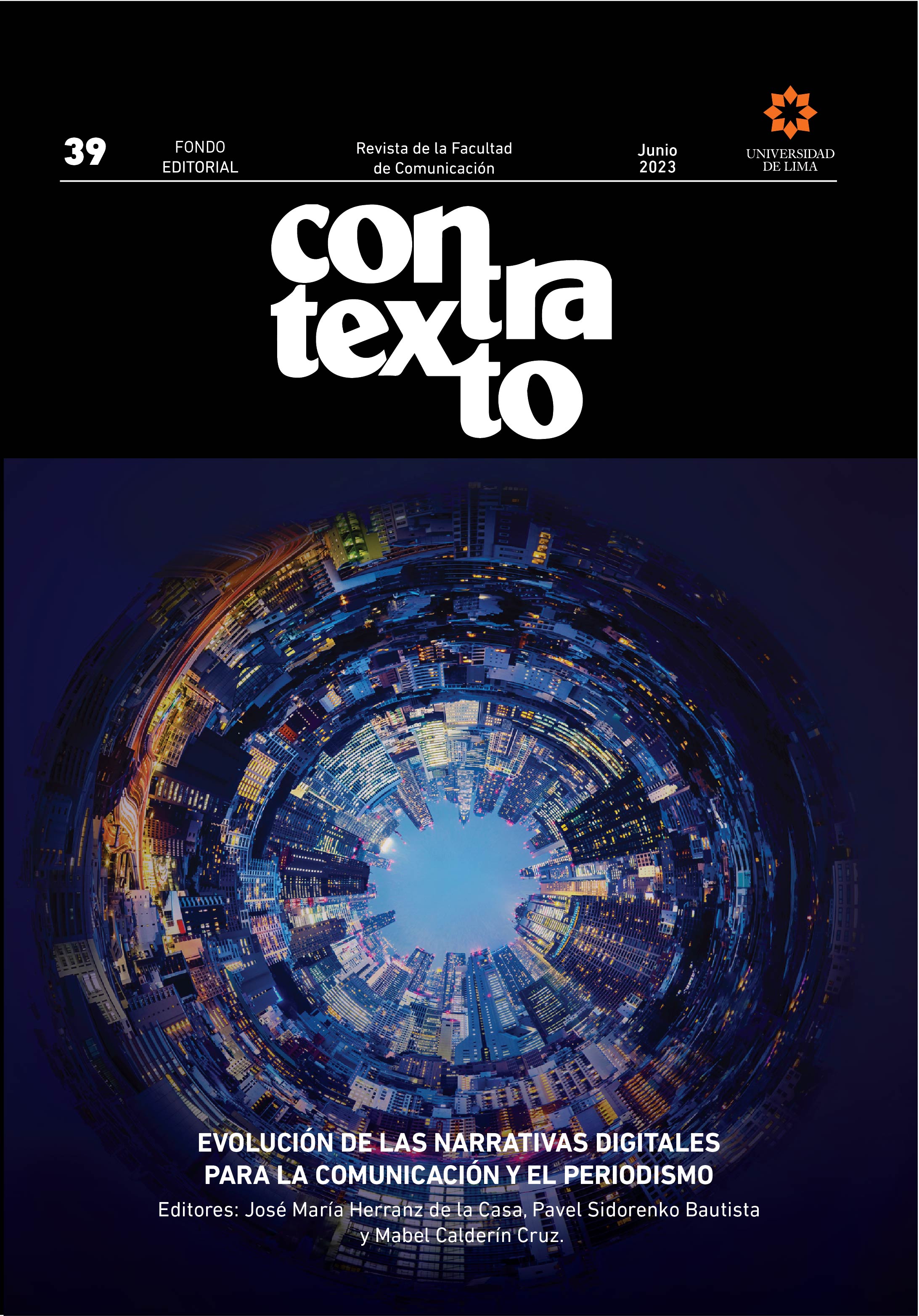Plataformización de noticias: análisis de los niveles de presencia en las plataformas de los medios periodísticos portugueses
DOI:
https://doi.org/10.26439/contratexto2023.n39.6011Palabras clave:
periodismo digital, mapeo de medios periodísticos, Portugal, plataformas de noticiasResumen
La plataformización de las noticias es un fenómeno global que se caracteriza por la creciente centralidad de las redes sociales y los motores de búsqueda en la distribución de noticias que transforman a los medios informativos en productores de contenidos complementarios a estos ecosistemas digitales. En este contexto, la investigación aplicó un análisis cuantitativo basado en la intersección de los estudios de mapeo de medios y en los estudios de plataformización para comprender cómo los periódicos portugueses se posicionan en las plataformas. Se llevaron a cabo tres etapas: codificación y mapeo de los medios de comunicación; clasificación de los niveles de presencia; y caracterización y comparación entre los diferentes niveles. La clasificación se efectuó con la combinación de análisis de conglomerados jerárquico y no jerárquico, en la que se identificó tres niveles de presencia en plataformas —bajo, medio y alto— como Facebook, Instagram, Twitter y YouTube. Se concluye que el alcance y el medio de origen son factores relevantes, pero esta relación no es directa, ya que la integración de los periódicos portugueses también depende de la adaptación a la lógica de las plataformas digitales y de las formas en que presentan sus contenidos según el potencial y las audiencias de cada ambiente comunicacional.
Descargas
Referencias
Altheide, D. (2015). Media Logic. In G. Mazzoleni (Ed.), The International Encyclopedia of Political Communication (pp. 1-6). John Wiley and Sons. https://doi.org/10.1002/9781118541555.wbiepc088
Boczkowski, P. (2021). Abundance: on the experience of living in a world of information plenty. Oxford University Press.
Cardoso, G., Paisana, M., & Pinto-Martinho, A. (2022). Digital News Report Portugal. Obercom. https://obercom.pt/wp-content/uploads/2022/06/DNRPT_2022_FINAL_14Jun.pdf
Carvalho, H. (2017). Análise multivariada de dados qualitativos: utilização da análise de correspondências múltiplas com o SPSS. Sílabo.
Dijck, J. van, Poell, T., & Waal, M. de. (2018). The platform society: public values in a connective world. Oxford University Press.
Dijck, J. van, & Poell, T. (2013). Understanding social media logic. Media and Communication, 1(1), 2-14.
Ekström, M., & Westlund, O. (2019). The dislocation of news journalism. A conceptual framework for the study of epistemologies of digital journalism. Media and Communication, 7(1), 259-270. https://doi.org/10.17645/mac.v7i1.1763
Entidade Reguladora para a Comunicação Social. (2021). Listagem de Registos da Erc. https://www.Erc.Pt/Pt/Listagem-Registos-Na-Erc.
Gerlitz, C., & Helmond, A. (2013). The like economy: social buttons and the data-intensive web. New Media and Society, 15(8), 1348-1365. https://doi.org/10.1177/1461444812472322
Gillespie, T. (2010). The politics of “platforms”. New Media and Society, 12(3), 347-364. https://doi.org/10.1177/1461444809342738
Gillespie, T. (2014). The Relevance of Algorithms. In T. Gillespie, P. J. Boczkowski & K. A. Foo (Eds.), Media technologies: essays on communication, materiality, and society (pp. 167-193). MIT Press.
Hair, J. F., Black, W., Babin, B., Anderson, R., & Tatham, R. (2009). Análise multivariada de dados (6.a ed.). Bookman.
Helmond, A. (2015). The platformization of the web: making web data platform ready. Social Media and Society, 1(2). https://doi.org/10.1177/2056305115603080
Negredo, S., Martínez-Costa, M., Breiner, J., & Salaverría, R. (2020). Journalism expands in spite of the crisis: digital-native news media in Spain. Media and Communication, 8(2), 73-85. https://doi.org/10.17645/mac.v8i2.2738
Newman, N., Fletcher, R., Robertson, C., Eddy, C., & Kleis Nielsen, R. (2022). Reuters Institute Digital News Report 2022. Reuters Institute for the Study of Journalism. https://reutersinstitute.politics.ox.ac.uk/sites/default/files/2022-06/Digital_News-Report_2022.pdf
Nielsen, R., & Fletcher, R. (2022). Concentration of online news traffic and publishers’ reliance on platform referrals: evidence from passive tracking data in the UK.
Journal of Quantitative Description: Digital Media, 2. https://doi.org/10.51685/jqd.2022.015
Nielsen, R., & Ganter, S. A. (2022). The power of platforms: shaping media and society. Oxford University Press.
Poell, T., Nieborg, D., & Dijck, J. van (2020). Plataformização. Fronteiras - estudos midiáticos, 22(1), 2-10. https://doi.org/10.4013/fem.2020.221.01
Salaverría, R., Martínez-Costa Pérez, M., & Breiner, J. (2018). Mapa de los cibermedios de España en 2018: análisis cuantitativo. Revista Latina de Comunicación Social, (73), 1034-1053. https://doi.org/10.4185/rlcs-2018-1295
Salaverría, R. (2017). Tipología de los cibermedios periodísticos: bases teóricas para su clasificación. Revista Mediterránea de Comunicación, 8(1), 19-32.
Steensen, S., & Westlund, O. (2020). What is digital journalism studies?. Routledge. https://doi.org/10.4324/9780429259555
Publicado
Número
Sección
Licencia
Todos los trabajos publicados están sujetos a una licencia CC BY 4.0 Creative Commons (actualizado el 1 de marzo de 2021).
El contenido de la revista se puede compartir en cualquier material o formato. Asimismo, se puede adaptar, contribuir y transformar. Ambas posibilidades sólo están permitidas en la medida en que cumplan las siguientes condiciones:
- Atribución: Se debe otorgar crédito donde sea debido, proporcionar un enlace a la licencia e indicar los cambios en caso se realice alguno. Esto debe hacerse de la manera que se considere apropiada, sin sugerir que el licenciante lo promueva a usted o su uso del material.
Derechos de propiedad
Los derechos patrimoniales de Contratexto se publican bajo una licencia Creative Commons BY 4.0, lo que permite a los autores mantener los derechos patrimoniales de su obra sin restricciones.
Si un trabajo publicado en Contratexto fuera copiado, distribuido, difundido o cualquier otra actividad contemplada en la licencia antes mencionada, se deberá mencionar de manera visible y expresa al autor o autores y a la revista.
Auto-archivo
Esta revista permite y anima a los autores/as a publicar artículos enviados a la revista en sus sitios web personales o en depósitos institucionales, tanto antes como después de su publicación en esta revista, siempre y cuando proporcionen información bibliográfica que acredite, si procede, su publicación en ella.


















